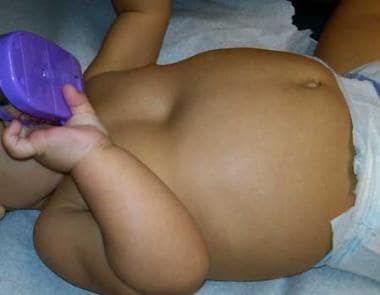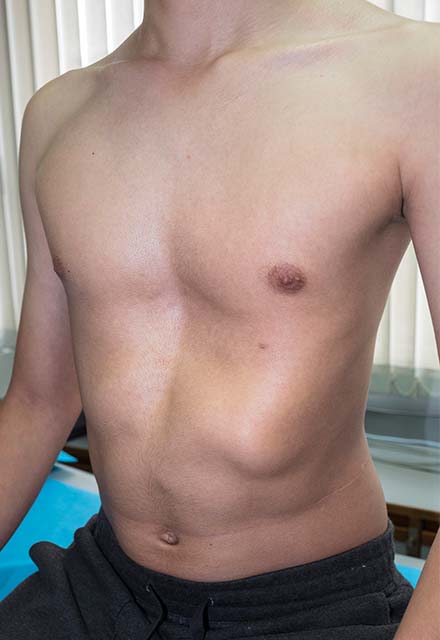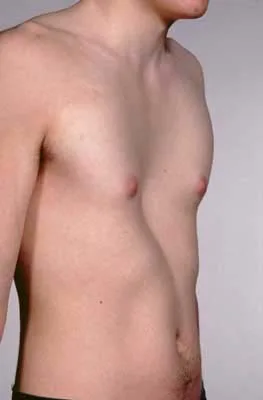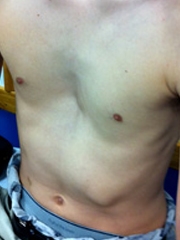Infants and very young children are usually not considered for surgery unless very severe abnormalities or other illnesses necessitate earlier surgery. The breastbone, or sternum, and some of the ribs grow abnormally, causing a depression in the middle of the chest.

Pectus Excavatum My Tips For Organizing Surgery And Finding An Insurance Cover - Hubpages
It occurs mostly in boys and frequently more members in a family are affected.

Pectus excavatum baby surgery. Nuss and ravitch procedure are the two most commonly used surgeries to repair pectus excavatum in children. The chest muscles must be raised from the breastbone and ribs. The traditional approach to repairing pectus excavatum requires that an incision be made across the child's chest below the level of the nipples.
Pectus excavatum, also known as concave chest or funnel chest, is a deformity of your child's chest wall. At chop, the nuss procedure is the most common surgical procedure for pectus excavatum. The surgeon makes two small.
The cardiothoracic team in collaboration with the. About the nuss procedure the nuss procedure involves two small incisions made on each side of the chest. Fast facts about pectus excavatum repair surgery.
Two types of surgery are used: Pe, or ‘funnel chest’, appears as a depression of the sternum; Pectus excavatum may be mild or severe.
Pectus excavatum is a condition where the bones of the sternum and ribs grow inward, creating a sunken area of the chest. The minimally invasive repair (or nuss procedure) Pectus excavatum (pe) and pectus carinatum (pc) are the most common of these.
This is likely due to the normal aging process and increasing difficulties compensating for the functional impairments associated with pectus excavatum. Pectus abnormalities cover a range of deformities affecting the anterior chest wall, specifically the sternum and adjacent rib cartilages. Do this exercise every morning and evening.
The surgical technique in children is similar to that of adults, except for the higher forces involved that often necessitate sternal elevation and more involved stabilization strategies. This condition is normally genetic, considered epts,. The nuss procedure is a minimally invasive technique for surgical repair that involves placement of a concave steel bar under the sternum.
1, 2 pectus excavatum may be associated with connective tissue disorders such as marfan and. Respiratory and cardiac function tests are usually normal, despite the presence of the defect. Stand up straight with your shoulders back.
P ectus excavatum rarely causes symptoms in infants or children. In this regard, is pectus excavatum surgery painful? It may be asymmetrical, with the right side deeper
Both traditional open surgery (ravitch repair) and minimally invasive techniques (nuss repair) are used to correct pectus excavatum. Although the exact cause of. Surgeons at texas children’s generally perform a minimally invasive operation called the nuss procedure to correct pectus excavatum.
Repair is typically done in the teenage years, once the pubertal growth spurt is underway or completed. This pain may be intermittent and may or may not be associated with exercise. The cartilage pushes the breastbone (sternum) inward.
The surgeries for pectus excavatum and pectus carinatum are both done under general anesthesia. The pectus may become more severe or apparent during periods of rapid growth. This happens because several ribs and the breastbone grow abnormally.
There are several surgical options to correct pectus excavatum. Sometimes prior to surgery, an anesthesiologist may insert an epidural catheter into the back while your child is asleep. Patients that have severe symptomatic pe are offered minimally invasive repair of pectus excavatum (mirpe).
Your child’s surgery will take place at children’s hospital. Severe pectus excavatum may cause problems with the heart and lungs. Wearing posture braces from a very young age is an excellent way for your kid to develop a proper, sturdy posture, which will ease the process of treating pectus excavatum.
This can interfere with the ability of the heart and lungs to properly function. The main indication for surgical repair in childhood is cosmetic. What is a pectus excavatum?
The condition is not always noticeable at birth, but is often apparent by the time a child is 2 to 3. In some cases, surgery can treat pectus excavatum. The depression may be in the center of the chest or more pronounced on one side.
Pectus excavatum does not require any treatment. Pectus excavatum is a condition in which the breastbone (sternum) of the chest is caved in. An epidural is a small tube that will allow your child to receive pain medication after surgery.
Surgical repair is an elective procedure and requires insurance approval before proceeding. Pectus excavatum, also referred to as “sunken chest,” is a depression in the chest wall. The child then must stay in the hospital for four to six days after surgery.
Patients also experience chest and back pain. Pectus excavatum, a deformity of the sternum and ribs caused by an unbalanced costochondral hypertrophy, is a congenital abnormality, with a prevalence of 1 per 1000 patients; A child can be born with pectus or develop their pectus during their pubertal growth spurt.
During this operation, a curved stainless steel bar is inserted in the chest through small incisions on either side, and is guided between the sternum and the heart under direct visualization with a camera through a small incision just below the. How is pectus excavatum typically treated? Early referral to a pediatric surgeon is important to determine surgical options and optimize treatment.
Pectus excavatum is a depression of the sternum and costal cartilages which may present at birth, or more commonly during the teenage growth. The minor corrective operation is. How is pectus excavatum treated?
Our experts most often use the nuss procedure, which is a minimally invasive approach to repair pectus excavatum. Kids with mild pectus excavatum — who aren't bothered by their appearance and don't have breathing problems — typically don't need treatment. The condition does not present a danger to the child.
The open (or modified ravitch) procedure; Both techniques generally improve chest appearance. The pectus excavatum repair is a surgery to fix the shape of the bone in the middle of the chest, called the sternum or breastbone, so that the lungs and the heart are not squeezed by the inward curve of the chest.
Pectus excavatum is usually cured by surgery, but occasionally it can develop again years later.

Nuss Procedure For Pectus Excavatum Background Indications Contraindications

Pectus Excavatum - Chest Wall - Stanford Childrens Health

Minimally Invasive Repair Of The Severe Pectus Excavatum In An Infant - Sciencedirect

Pectus Excavatum Symptoms Treatments And Complications

Penyebab Terjadinya Pectus Excavatum Alias Dada Cekung Orami

Kelainan Dada Cekung Berbahaya Kah Hbtkviorg

Pectus Excavatum Johns Hopkins Childrens Center

Learning About Pectus Excavatum Repair In Children

Minimally Invasive Repair Of The Severe Pectus Excavatum In An Infant - Sciencedirect

Pectus Program - Prisma Health - Upstate Childrens

Pdf Prenatal Diagnosis Of Pectus Excavatum

Kelainan Dada Cekung Berbahaya Kah - Indonesian Association Of Thoracic Cardiac And Vascular Surgeons

Penyebab Terjadinya Pectus Excavatum Alias Dada Cekung Orami

Pectus Excavatum From A Pediatric Surgeons Perspective - Abstract - Europe Pmc

Pectus Excavatum And Carinatum Repair Ucla Health

Magnets May Pull Kids With Sunken Chests Out Of Operating Room Shots - Health News Npr

Pectus Excavatum - Chest Wall Deformities Child Heart Specialist

Penyebab Terjadinya Pectus Excavatum Alias Dada Cekung Orami

Pectus Excavatum Childrens Hospital Of Philadelphia
